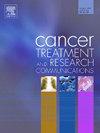Changes in the use of chemoradiotherapy for non-small cell lung cancer after guideline implementation in Finland between 2016 and 2020
IF 2.4
Q3 Medicine
引用次数: 0
Abstract
Background
Following treatment with chemoradiotherapy (CRT), approximately 30 % of patients with stage III unresectable non-small cell lung cancer (NSCLC) can achieve long-term remission with the possibility of a cure.[1,2,3]. CRT was deemed to be underutilized in Finland compared with the lung cancer incidence. Herein, we examined the potential increase in CRT use following the introduction of national guidelines to improve and standardize NSCLC treatment nationally.
Materials and methods
We compared the use of CRT before and after the implementation of updated CRT guidelines in 2016 and 2020. Data was gathered on all patients treated with CRT from every radiotherapy unit, in Finland, for a total of 13 radiotherapy units.
Results
Overall, 53 and 77 patients with NSCLC were treated with CRT in 2016 and 2020, respectively; thus, CRT use increased significantly by 45 %. There was only a slight overall increase in the incidence of lung cancer, with 2734 patients reported in 2016 and 2801 in 2020, according to the Finnish Cancer Registry report from 2020. Overall (OS) and progression-free survival (PFS) were analyzed over 2 years. The median PFS was 10 and 15 months in patients treated in 2016 and 2020, respectively. The median OS was not reached in either group. There were no statistically significant differences between the groups.
Conclusion
Implementation of the national guideline increased CRT use and altered clinical practice across the country, without compromising treatment efficacy or survival. CRT was provided more uniformly after the implementation of national guidelines.
2016年至2020年芬兰指南实施后非小细胞肺癌放化疗使用的变化
背景:在接受放化疗(CRT)治疗后,大约30%的III期不可切除的非小细胞肺癌(NSCLC)患者可以实现长期缓解,并有治愈的可能性[1,2,3]。与肺癌发病率相比,CRT在芬兰被认为未得到充分利用。在此,我们研究了在引入国家指南以改善和规范全国非小细胞肺癌治疗后,CRT使用的潜在增加。材料和方法:我们比较了2016年和2020年更新的CRT指南实施前后的CRT使用情况。数据收集来自芬兰每个放疗单位的所有接受CRT治疗的患者,共13个放疗单位。结果:总体而言,2016年和2020年分别有53例和77例NSCLC患者接受了CRT治疗;因此,CRT的使用显著增加了45%。根据芬兰癌症登记处2020年的报告,肺癌的发病率总体上只有轻微的增加,2016年报告了2734例患者,2020年报告了2801例。分析2年的总生存率(OS)和无进展生存期(PFS)。2016年和2020年接受治疗的患者的中位PFS分别为10个月和15个月。两组患者均未达到中位总生存期。两组间无统计学差异。结论:国家指南的实施增加了CRT的使用,改变了全国的临床实践,但不影响治疗效果或生存。国家指导方针实施后,CRT的提供更加统一。
本文章由计算机程序翻译,如有差异,请以英文原文为准。
求助全文
约1分钟内获得全文
求助全文
来源期刊

Cancer treatment and research communications
Medicine-Oncology
CiteScore
4.30
自引率
0.00%
发文量
148
审稿时长
56 days
期刊介绍:
Cancer Treatment and Research Communications is an international peer-reviewed publication dedicated to providing comprehensive basic, translational, and clinical oncology research. The journal is devoted to articles on detection, diagnosis, prevention, policy, and treatment of cancer and provides a global forum for the nurturing and development of future generations of oncology scientists. Cancer Treatment and Research Communications publishes comprehensive reviews and original studies describing various aspects of basic through clinical research of all tumor types. The journal also accepts clinical studies in oncology, with an emphasis on prospective early phase clinical trials. Specific areas of interest include basic, translational, and clinical research and mechanistic approaches; cancer biology; molecular carcinogenesis; genetics and genomics; stem cell and developmental biology; immunology; molecular and cellular oncology; systems biology; drug sensitivity and resistance; gene and antisense therapy; pathology, markers, and prognostic indicators; chemoprevention strategies; multimodality therapy; cancer policy; and integration of various approaches. Our mission is to be the premier source of relevant information through promoting excellence in research and facilitating the timely translation of that science to health care and clinical practice.
 求助内容:
求助内容: 应助结果提醒方式:
应助结果提醒方式:


